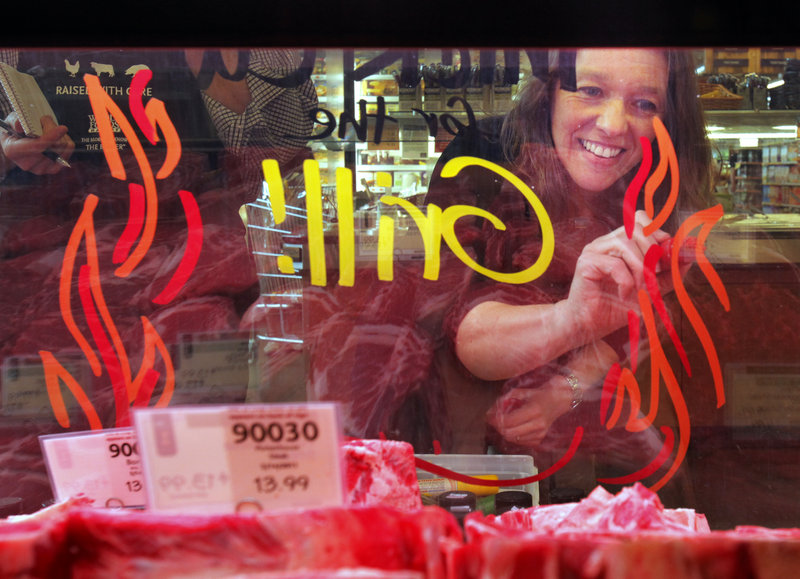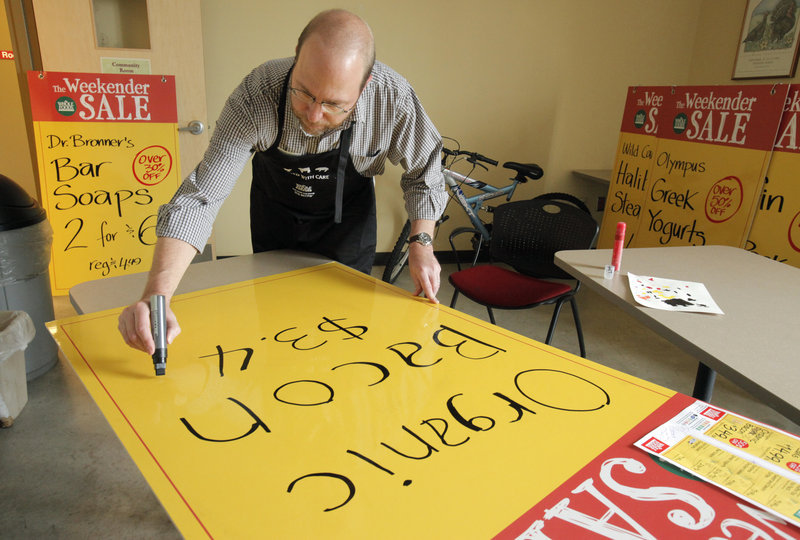PORTLAND – Talk about grade school flashbacks.
While trying to do some of the work of a sign maker at Whole Foods Market, I found myself staring at the alphabet, trying my best to copy the letters exactly.
They were all there, A to Z, capitals and smalls. But this was a special alphabet, done in what’s called “the Whole Foods Hand.”
It’s basically a way of making letters and numbers by hand in a style that is specific to Whole Foods, so all the signs have the same look, artistry and precision, no matter who makes them.
“The number 9s and the A’s are probably the toughest,” said Leticia Plate, a store graphic artist/sign maker, as she walked me through the alphabet. “For the small A, you can make a backwards S with a line through it. But the 9s are just different.”
Luckily, I didn’t have to make a 9.
The project I was working on with Plate was a chalkboard sign for the prepared-food section, detailing that day’s stromboli selection. The top of the sign, advertising and illustrating stromboli, for $7.99 a pound, had been done by Plate earlier.
Now, with the chalk sign sitting on her drawing table in an upstairs office — it would be hung in the store later — she was preparing to list the ingredients in today’s specials.
As I watched, Plate quickly wrote out “Spicy Italian — pepperoni, hot Genoa salami, mozzarella” and some other ingredients I forgot. When it came time to list the ingredients in the vegan version, Plate handed me the chalk — sort of a marker version of chalk — which was easy to write with.
It took me about five minutes to do mine, glancing at the “Whole Foods Hand” alphabet frequently. I did “mushroom” and “kale” without much trouble, but then I got to “artichoke” and stalled.
Usually when I write, I have spell check. But there’s no such thing as spell check on a handmade sign.
“We know how to spell everything,” Plate said with a laugh. But she admitted that she and fellow sign maker Wendy Graham have cheat sheets in foreign languages — French, Italian, Spanish — because so many food words are in those languages.
When I was finished, Plate, Graham and marketing team leader Barbara Gulino studied my work. “Not bad, you have potential,” they told me.
But they also confided that sign makers take about six months to really get good at “the hand.” Plate has an art degree and worked as an illustrator before getting this job.
Later, I saw the sign I worked on hanging over the pizza oven. It was obvious that half the sign was done by someone not yet proficient in “the hand.”
“If you were working here and had done that, we wouldn’t have hung that,” said Gulino. “We would have had you practice a lot more.”
The store is currently looking to hire a third sign maker, Gulino told me. (There’s a job description on the store’s website.)
Walking through the store with Plate, I realized that a huge proportion of the store’s signs are handmade. There are little paper signs on shelves with just a product and price, done by hand. And there are hundreds of black chalkboard and foam signs listing ingredients, specials, the farms that different foods come from, sales and locations of products.
Most are done in brightly colored marker or chalk, and many are illustrated with whimsical drawings. Plate once drew apples doing the tango for a sign locating apples from Argentina.
When I’ve been in Whole Foods before, I just assumed the signs had been printed in such a way as to make them look handmade. But Gulino explained that doing the signs by hand, and adding whimsy, is all part of Whole Foods’ effort to differentiate itself from competitors.
Plus, it’s more eco-friendly because the chalk and foam signs are reusable. Just a little Windex wipes off the old message, leaving it ready for a new one.
Plate and her co-workers routinely patrol the store, looking for signs that need to come down and be updated, as well as for signs that have been scratched or smeared.
One of the challenges to Plate’s job is that lots of people like me just assume lettering done so precisely can’t possibly be done freehand. So when we went to do some lettering on the glass case at the butcher shop, Plate showed me where people had scratched at the grass illustrating “grass-fed” beef.
Then we went to the gelato case, and the word “gelato” had scratches on it too.
“People want to see if it’s real, so they scratch it,” said Plate.
Staff Writer Ray Routhier can be contacted at 791-6454 or at:
rrouthier@pressherald.com
Send questions/comments to the editors.




